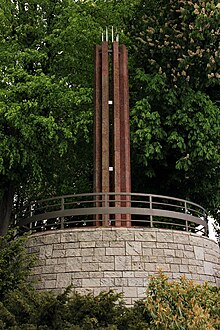Gustav August Munzer
Gustav August Munzer (born January 9, 1887 in Oerlsdorf ; † August 23, 1973 in Düsseldorf ) was a German architect . His most famous building is the Laboe Naval Memorial .
Life
Munzer studied from 1904 to 1907 at the building trade school in Coburg and then found his first job in the office of the architect Willroth in Flensburg . From 1908 to 1910 he worked for the architect Lauritz Petersen Thaysen in Tondern ( Tønder , Denmark). In 1910 Munzer went to the Düsseldorf School of Applied Arts , where Wilhelm Kreis was one of his teachers . Although he continued to take courses at the arts and crafts school until 1913, he was already self-employed as an architect in 1911.
In 1915 Munzer married the daughter of a building councilor, and the marriage resulted in three children. He was a member of the German Werkbund (DWB) and the Association of German Architects (BDA); In 1939 he was appointed professor - probably mainly because of the generally positive assessment of the naval memorial (see titular professor ). He practiced his profession until about 1970, his special focus was on inexpensive housing for workers and employees; with this aim he created several housing estates. Munzer's extensive estate, consisting of photos, postcards and plans, is in the Düsseldorf city archive.
buildings
(Selection)
- 1919–1920: Buildings of the Burgerhout (Bourgerkant) shipyard in Rotterdam ( Netherlands )
- 1921 ff .: Settlements in Bensberg ( Rosenhecke ), Hochemmerich and Langenfeld ( Steinrausch )
- before 1924: Monument to the fallen in Orsoy
- before 1924: assembly hall and welfare building for "Hafa" Maschinenbau AG in Düsseldorf
- 1924–1925: Apartment building at Prinz-Georg-Straße 100 in Düsseldorf
- It is a nine-storey house with eighteen comfortable apartments, which is Germany's first high-rise in the field of residential construction. The top two, staggered storeys were destroyed in the war. The building has been a listed building since 1984.
- 1925–1926: Apartment building at Camphausenstrasse 8–10 in Düsseldorf
- 1926: Buildings for the " GeSoLei " exhibition in Düsseldorf
- Special exhibition hall for the Degerma milk company
- Hall 39 of the German Brewers Association
- Hall 9
- Entrance building on Cecilienallee
- 1927–1928: Residential and housing developments at Yorckstrasse 2–20 in Düsseldorf
- 1927–1929: Residential and residential buildings Quirinstrasse 20–22, Arnulfstrasse 8–18
- 1927–1936: Laboe Naval Memorial near Kiel
- In 1927 Munzer took part in an architecture competition organized by the German Navy Federation . Formally, the first prize was awarded to the Bremen architect Heinz Stoffregen , although the jury liked Munzer's expressionist design better. However, this would have far exceeded the estimated construction costs of 500,000 Reichsmarks. The judges therefore recommended changing the design. Munzer followed suit and was commissioned with the execution. The building, completed in 1936 and inaugurated in the presence of Adolf Hitler , made Munzer famous far beyond Düsseldorf.
- 1931 Memorial of the Fallen of the Christian-Albrechts-University in the palace garden / Düsternbrooker Weg, Kiel
- 1935: "Josef Goebbels Youth Hostel" in Düsseldorf-Oberkassel (together with Karl Früh)
- after 1945: settlement in Düsseldorf-Stockum
- 1955–1961: "Norbert-Schmidt-Siedlung" in Düsseldorf-Gerresheim
literature
- New settlements in the Rhine Province, IV: The settlements of Bensberg, Hochemmerich and Langenfeld - by Arch. GAMunzer, DWB, Arch. BDA, Düsseldorf , in: Rh. Blätter für Wohnungswesen und Bauberatung, Jg. 17, 1921, H. 7/8 (July / August), pp. 164-172.
- Hans Arthur Lux (Ed.): Düsseldorf. German Art and Publishing Institute, Düsseldorf 1925.
- Wilhelm Busch: Buildings from the 1920s on the Rhine and Ruhr. Architecture as a means of expression. Bachem Verlag, Cologne 1993, ISBN 3-7616-1089-0 .
- John Zukowsky (Ed.): Architecture in Germany 1919–1939. The diversity of modernity. Prestel, Munich 1994, ISBN 3-7913-1366-5 .
- Roland Kanz, Jürgen Wiener (ed.): Architectural guide Düsseldorf. Dietrich Reimer Verlag, Berlin 2001, ISBN 3-496-01232-3 .
- Jürgen Wiener (Hrsg.): The Gesolei and the Düsseldorf architecture of the 20s. JP Bachem, Cologne 2001, ISBN 3-7616-1445-4 .
Web links
- Biographical notes on Munzer by the art historian Marco Kieser
- About the exhibition Schaffendes Volk 1937 and the architects involved (with careless mistakes!) ( Memento from September 23, 2010 in the Internet Archive )
- The estate of the architect Professor Gustav August Munzer (1887–1973) (PDF; 1.6 MB)
Individual evidence
- ^ Nils Aschenbeck: Heinz Stoffregen 1879–1929. Architecture between modern and avant-garde. Vieweg, Braunschweig / Wiesbaden 1990, ISBN 3-528-08746-3 .
- ^ Archive information from the German Marine Federation eV
- ↑ Spelling in the photographically handed down house inscription, meaning Joseph Goebbels
| personal data | |
|---|---|
| SURNAME | Munzer, Gustav August |
| BRIEF DESCRIPTION | German architect |
| DATE OF BIRTH | January 9, 1887 |
| PLACE OF BIRTH | Oerlsdorf |
| DATE OF DEATH | 23rd August 1973 |
| Place of death | Dusseldorf |

